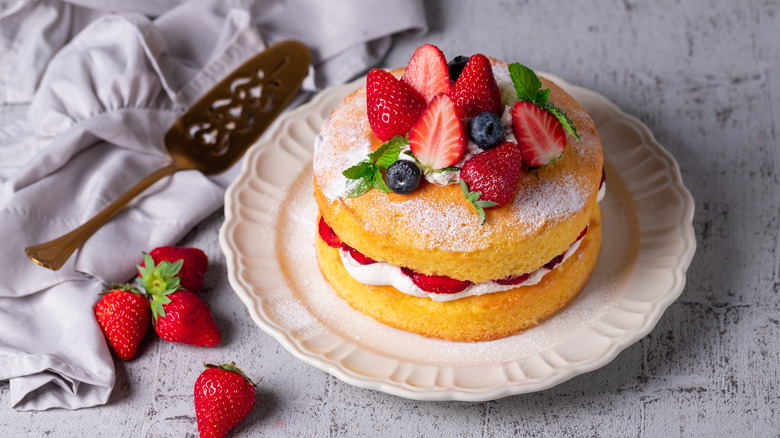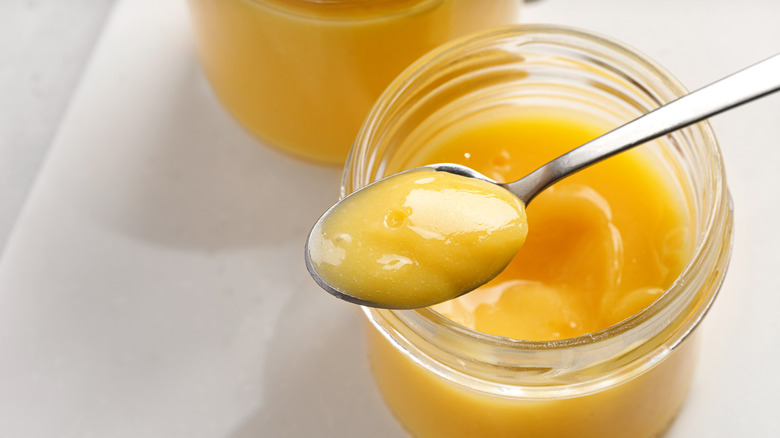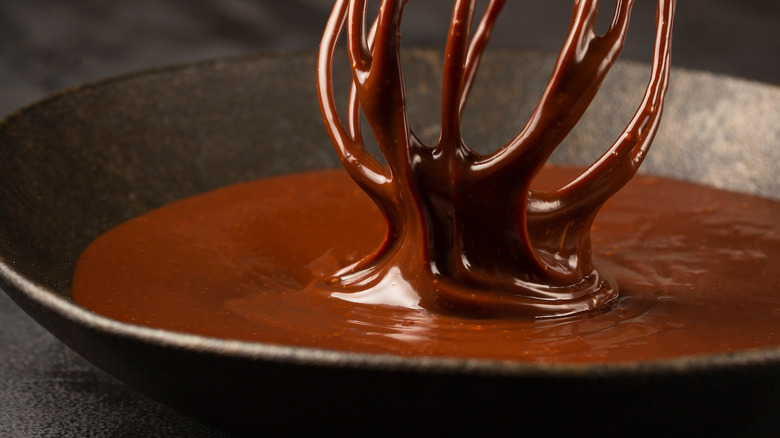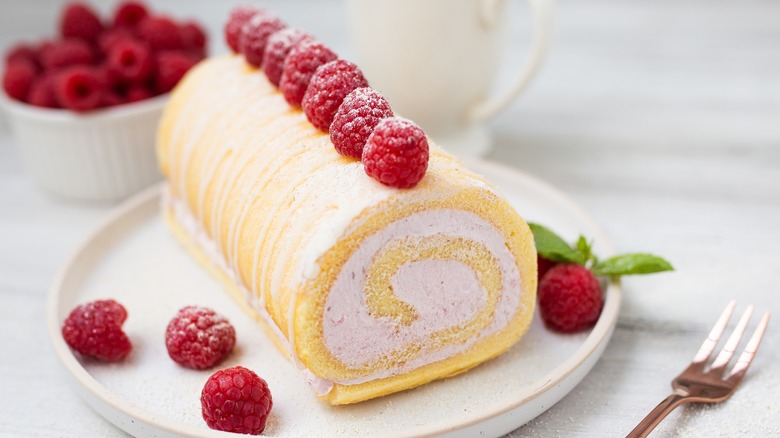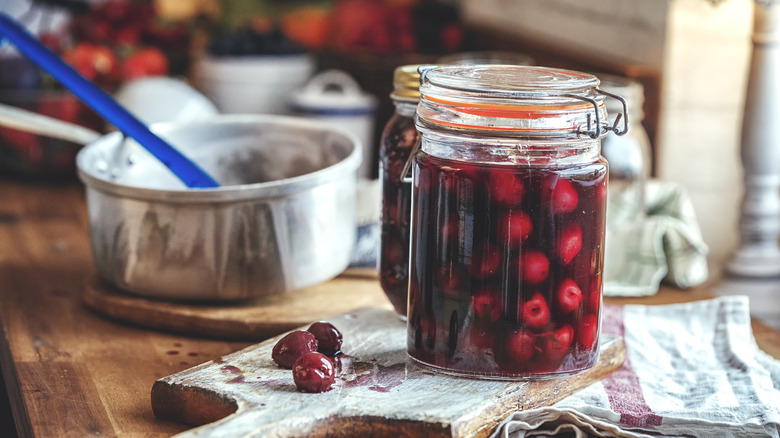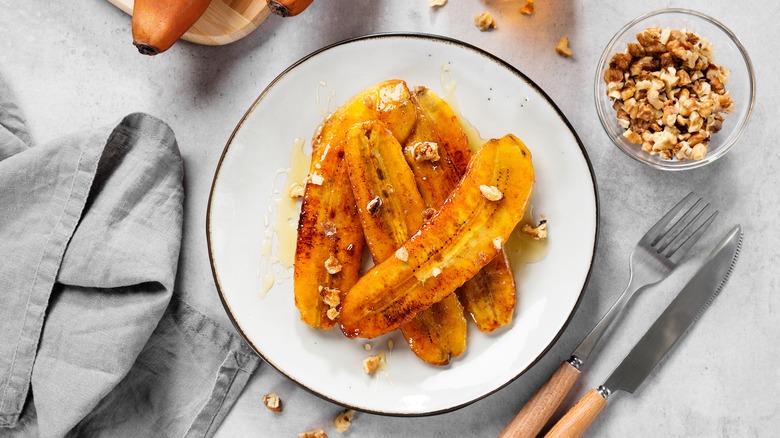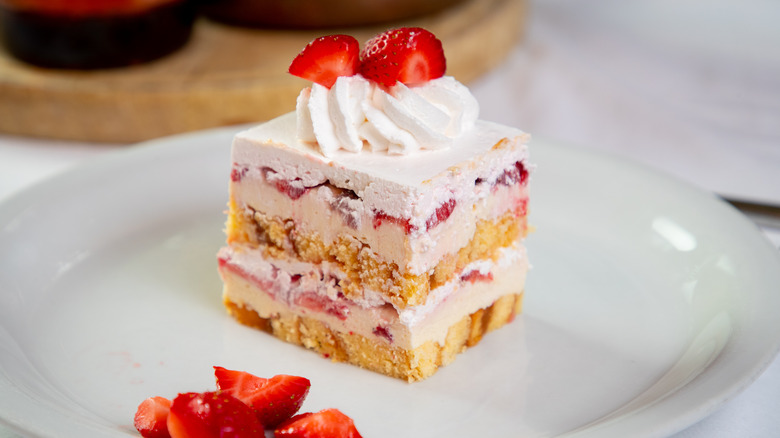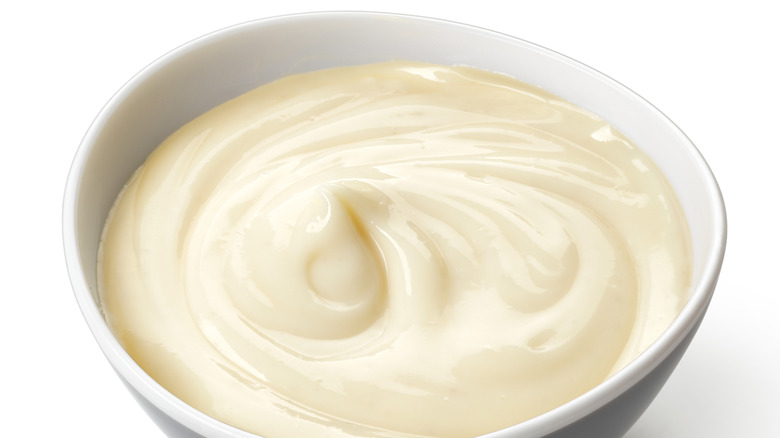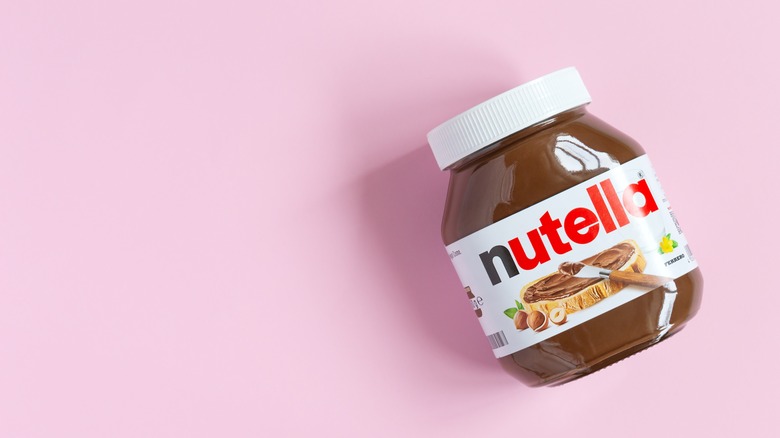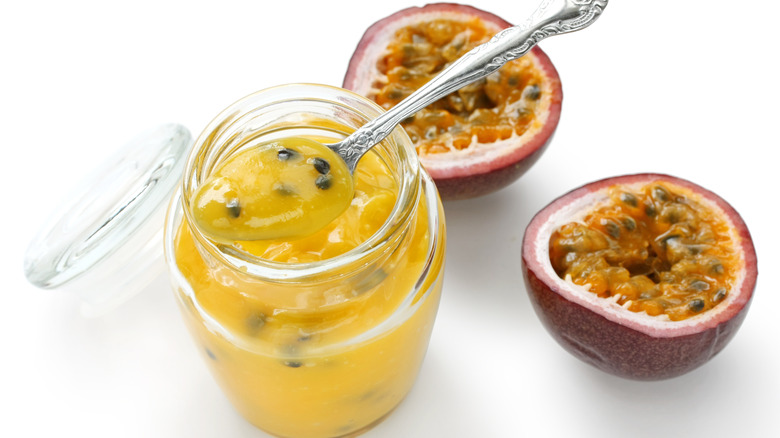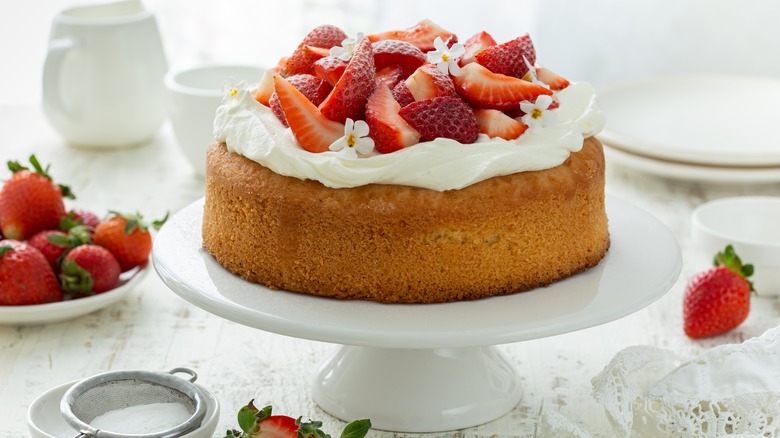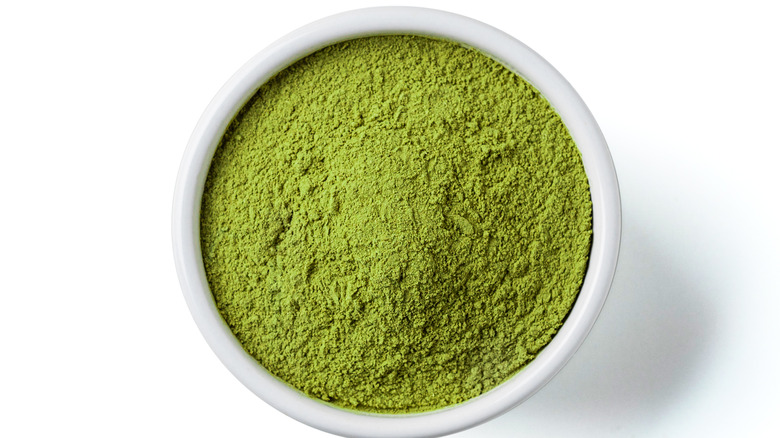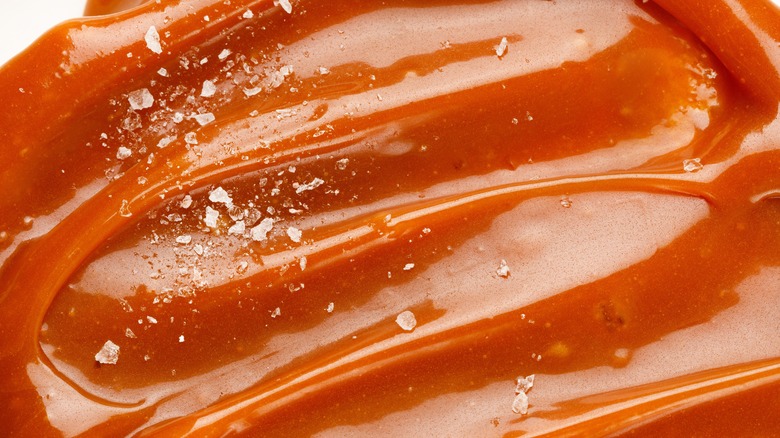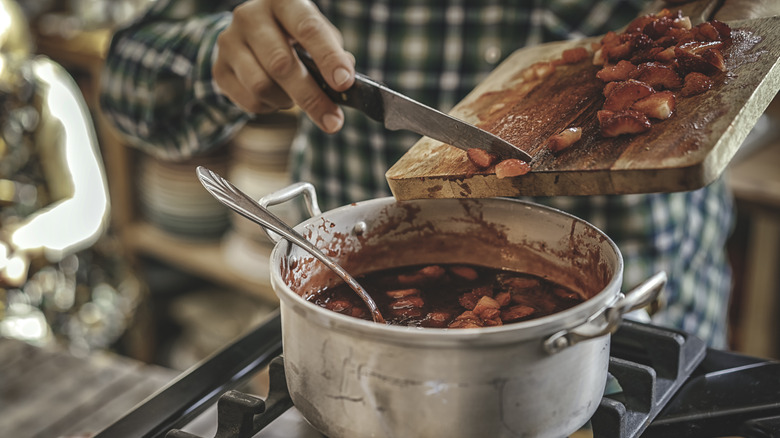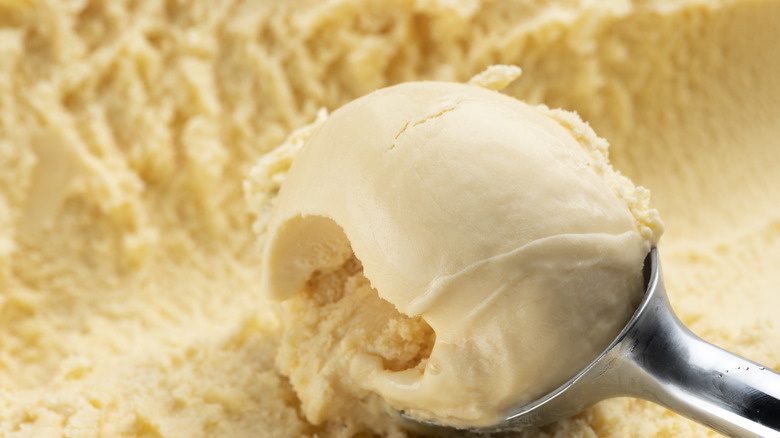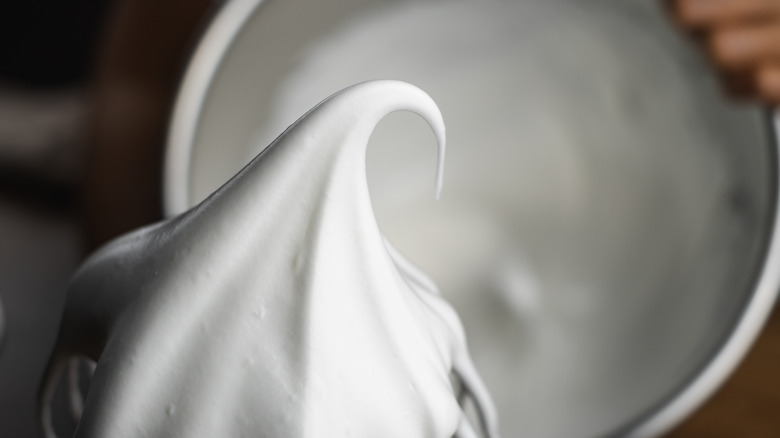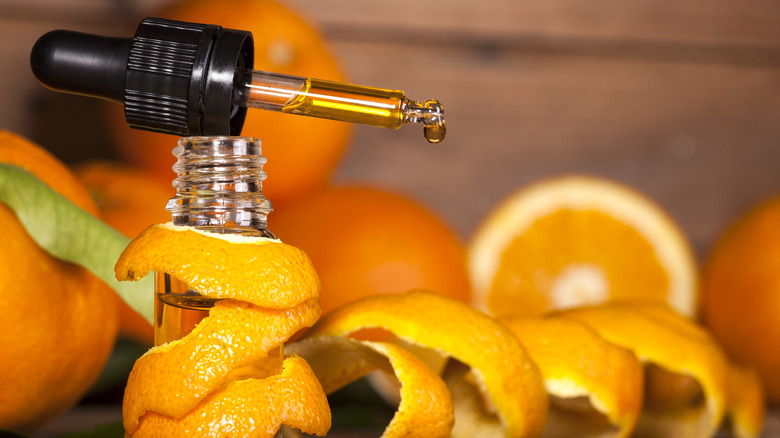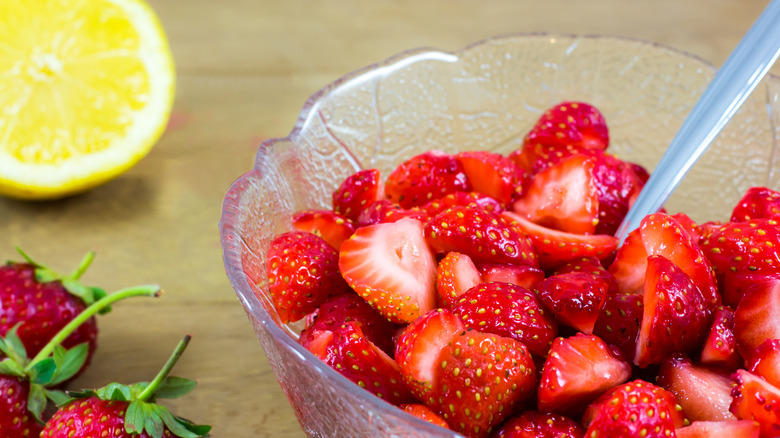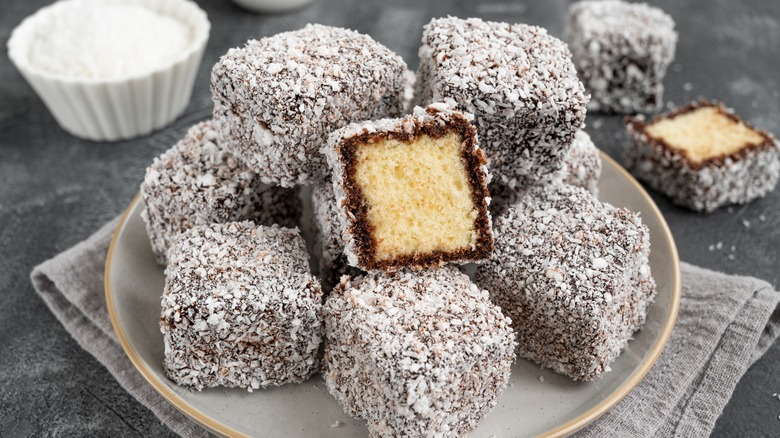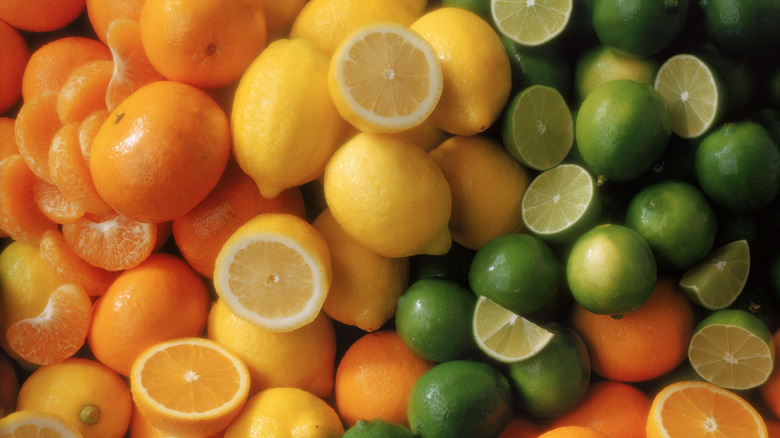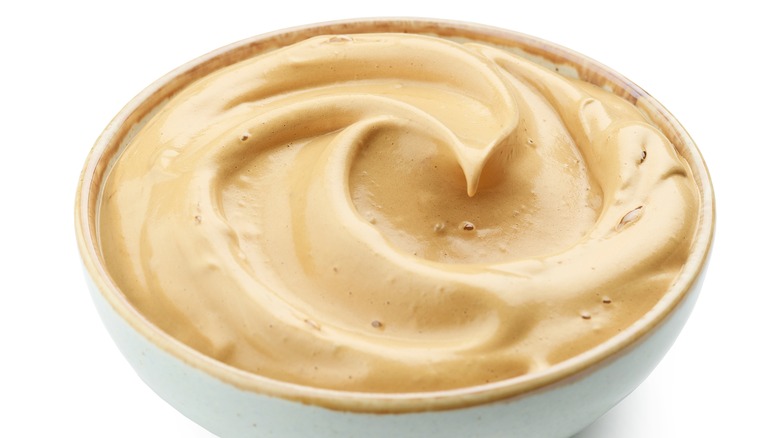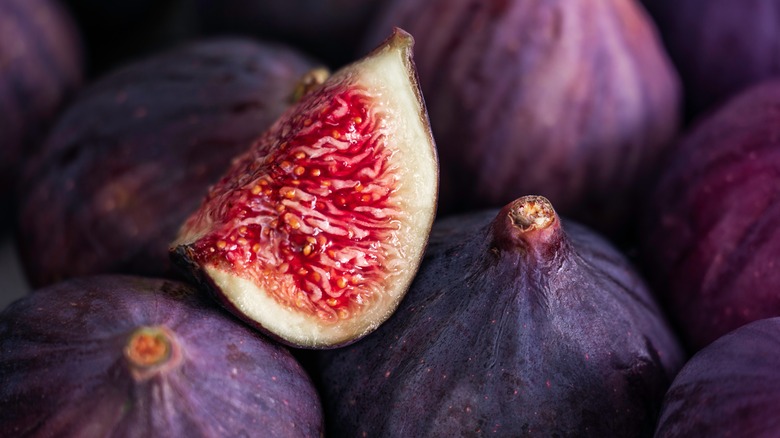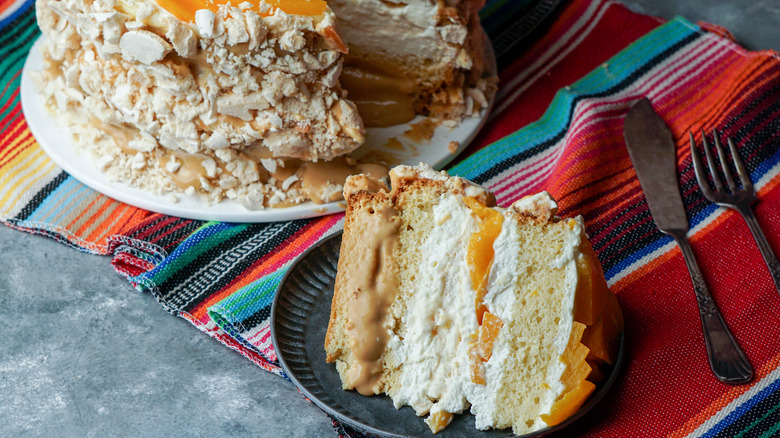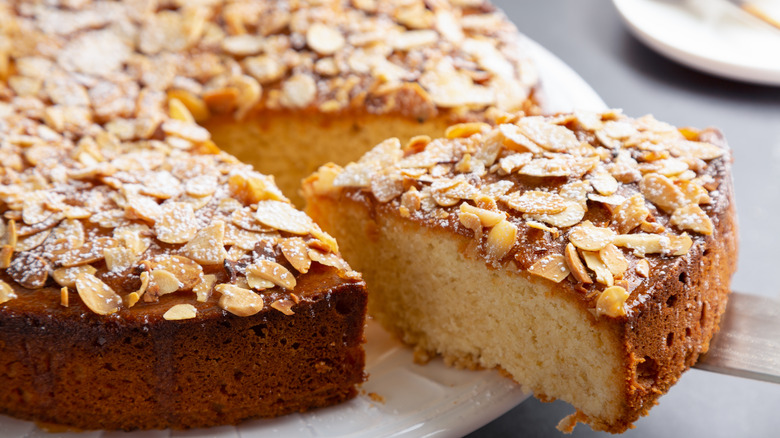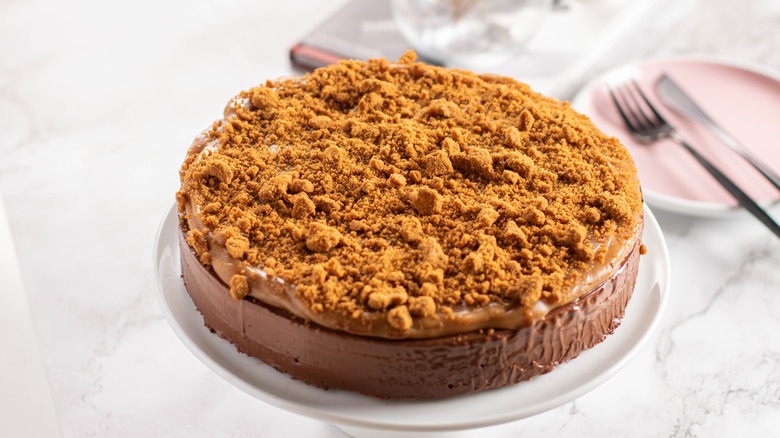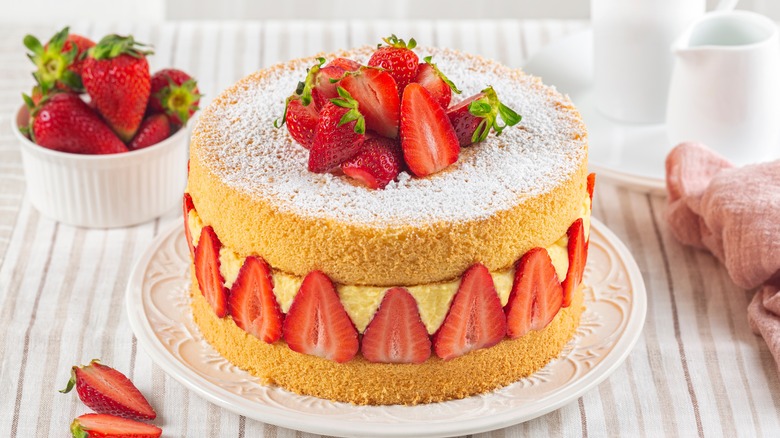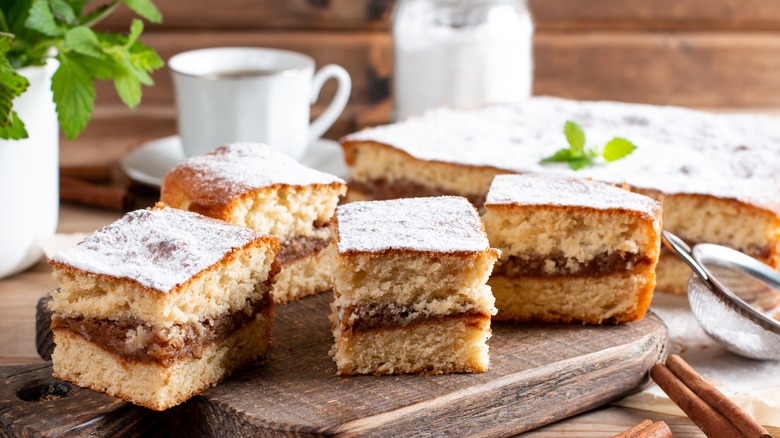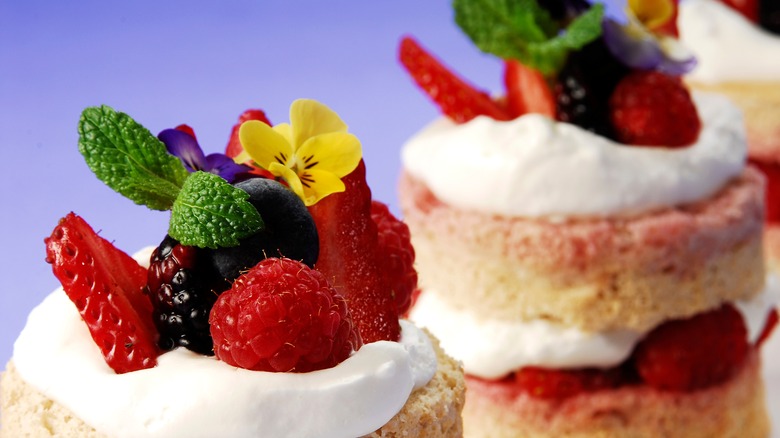29 Toppings That Take Sponge Cake To The Next Level
Light, bright, and mildly sweet — it's what we think of when we hear "sponge cake." Sponge cake is not just any type of cake (even though the layers of a cake are called sponges). By definition, this dessert features the standard ingredients of eggs, flour, and sugar. It is not the same as chiffon cake, which uses denser ingredients like vegetable oil and baking soda to make a heavier, denser crumb. One popular type of sponge cake found in the United States is angel food cake, which calls for the baker to whip the egg whites to add structure and a delicate scaffolding to the cake in the absence of butter and egg yolks. The category also includes the Genoise sponge cake, which uses whipped egg for its height rather than any chemical leavening agents.
Since the classification of a sponge cake is quite vast, there are many opportunities for a baker to put their own creative spin on this baking classic. Here are some of the best ingredients to top and decorate your soft, towering dessert.
Lemon curd
Lemon curd is one of the most common toppings used for sponge cake because of its bright, tangy flavor. Curd is essentially a custard since it's made with eggs, butter, sugar, and, of course, fresh lemon juice. Lemon curd should be cooked over low heat to prevent burning and to help it thicken into the perfect filling between the layers of your sponge cake. Pair your lemon curd with a soft whipped topping and dried lemon slices for a zesty and bright dessert.
Chocolate ganache
Chocolate ganache is the perfect topping if you're looking for a dark, indulgent pairing to a chocolate or a vanilla sponge cake. For example, chocolate ganache, which is a combination of melted dark chocolate and butter, is used as a key topping for an elaborate classic opera cake. When chilled, the ganache solidifies into a thin sheet that makes the cake's appearance very recognizable. An alternative to adding a sheet of ganache to the top of your cake is to drip it down the sides for a visually-stunning appearance.
Buttercream frosting
Buttercream is one of the frostings every baker should learn to master. Its thick texture and sweet flavor make this frosting versatile for many types of cake — including sponge cake. You can pipe elegant buttercream designs on top of your cake or use it as a buffer for curds and jams between each layer. Since the flavor is relatively nuanced, you can pair it with a flavored sponge base, berries, or more sugar-heavy confections.
Fresh raspberries
Fresh raspberries are the perfect simple garnish for sponge cakes and rolls. Not only does the bright red color provide a powerful contrast to the other yellow and white ingredients, but each raspberry provides a refreshing pop in your mouth when you bite into the cake. We recommend pairing this produce with a raspberry jam filling and vanilla sponge base, but we could also see applications where it could provide brightness to a chocolate or pistachio-flavored sponge.
Cherry compote
Cherry compote is one of the most under-appreciated ingredients for decorating cakes. Our favorite way to use this ingredient is in a version of a Black Forest cake — with a decadent chocolate ganache, chocolate sponge, and fluffy whipped cream icing.
To make your cherry compote at home, which can also be used for cherry pie filling, cook down pitted cherries (fresh or frozen), a cornstarch slurry, almond extract, and sugar. If you would rather not have chunks of the cherries in your dessert, you can strain them out — or blend them into the juice using an immersion blender.
Caramelized bananas
Caramelized bananas are not only beautiful to look at atop a delicate sponge cake, but the flavor is complex yet familiar. You can make a twist on bananas foster at home (sans ice cream) and use the dish to garnish the top of your sponge cake.
This recipe coats each banana in a caramel sauce infused with cinnamon, nutmeg, and dark rum. Then, the bananas are torched to burn off the residual alcohol. Once the bananas have cooled enough, spoon them with the sauce atop your cake.
Whipped cream
If you're looking for a much lighter frosting option for your cake, skip the buttercream and go with a whipped cream topping. It's light and airy and pairs well with fruity toppings like strawberry jam, fresh berries, and bananas.
You can make this topping at home by whisking heavy cream or whipping cream until fluffy. The sweet ingredient that will change your whipped cream (and, by proxy, your sponge cake) forever is honey. A drizzle of honey will add a herbal undertone to your frosting — plus, it pairs well with almost any type of sponge you use it with.
Vanilla pudding
Vanilla pudding is the perfect ingredient to fill the inside of your sponge cake — plus, it can be made in a pinch with store-bought pudding powder. Although it can be paired with other fruity toppings, our favorite way to use this ingredient is to fill an upgraded Victoria sponge cake. The pudding, which is not historically used in the British dessert, adds a creamy flavor that helps disperse the sweetness of the jam and fresh whipped cream topping.
While we've only tried making sponge cake with vanilla pudding, it would be possible to substitute another pudding powder, like chocolate or cheesecake, into this recipe. You'll want to use the "Cook & Serve" pudding instead of the instant variety.
Nutella
Nutella is the sweet substitution in Queen Camilla's favorite cake: the Victoria sponge. She prefers the chocolate hazelnut spread between soft vanilla sponge layers instead of the more traditional fruit preserves.
Besides the Nutella, Camilla also tops her cake with pillows of whipped cream and powdered sugar. It's the perfect chocolatey confection for a fluffy sponge cake. If you want to go the extra mile with your Nutella topping, we recommend adding shaved hazelnuts and using a chocolate sponge instead of a vanilla one.
Passionfruit curd
Passionfruit curd has jumped into the baking spotlight in recent years thanks to its appearance in many of the recipes on the "Great British Baking Show." Like other types of curd, this ingredient is made by mixing together passionfruit flesh, sugar, lemon juice, eggs, and butter.
The flavor is more floral than other citrus curds and has the added textural benefit of tiny black seeds. The fragrant fruit is best accompanied as a sandwich layer of the sponge cake with an ample amount of whipped cream.
Cream cheese frosting
While cream cheese frosting certainly isn't the most popular topping for a sponge cake, its tanginess can add an elevated flavor to your dessert and complement other fresh fruits and berry toppings. You can also use it with more pungent ingredients like pineapple or as a flavor balancer for an autumnal apple filling. We prefer using cream cheese frosting instead of buttercream frosting for a sponge cake because it's not as heavy and doesn't tend to drown out the other toppings in the cake like butter-based icing does.
Matcha powder
Instead of grabbing a sieve of powdered sugar for your sponge cake, we recommend dusting it with matcha powder instead. It will add a mild, herbaceous flavor to your cake and works best with fresh raspberries and strawberries.
You might also consider adding matcha powder directly to your cake batter to develop a bright green hue. Ceremonial matcha tends to have a more pronounced color than culinary matcha, which is why we recommend using it for your sponge cake.
Salted caramel
Caramel and baked goods go hand-in-hand, which is why adding a bit of caramel sauce to the top of your sponge cake can make it look more refined — and make it taste better, of course. The best way to go about adding caramel to sponge cake is to swap out the caster sugar with brown sugar and add caramel directly to your sponge batter.
From there, infuse your buttercream with caramel and finish with a salted caramel drizzle on the top of your cake. Not only will this cake look straight out of a bakery, but it will taste like it, too.
Strawberry jam
We can't talk about sponge cake toppings without mentioning one of the most common fruity accents: strawberry jam. While there's nothing wrong with using strawberry jam to sandwich your sponge layers together, there's something special about making your own easy strawberry jam.
Cook down and mash your fresh (or frozen) strawberries with lemon juice and sugar, cool, and store in a jar in the fridge for up to 10 days. When you're ready to apply it to your sponge cake, pipe a buttercream, cream cheese, or whipped cream icing buffer and fill in with your homemade jam.
Ice cream
There's no ice cream cake like this one. Instead of opting for frosting on your sponge cake, completely cool each sponge layer and sandwich it with a scoop of your favorite ice cream. Once you've layered your sponge cake in a pan, transfer it to your freezer overnight to harden.
We like matching our ice cream flavor with our other toppings. For example, pair a strawberry ice cream with a vanilla sponge and cover it with macerated berries before serving. Or, stick to a salted caramel ice cream, cinnamon or vanilla sponge, and a drizzle of salted caramel sauce.
Meringue frosting
Although meringue frosting is more difficult to make than other types of frosting, it is beneficial to use when you need the frosting to hold its shape well. A meringue-based frosting, including strong egg whites, is best for piping designs on your sponge cake.
One type of sponge cake that uses a meringue frosting is a Cipriani cake. The layers of Italian sponge and vanilla cream are finished with a coating of sweet meringue frosting brûléed into a professional-looking dessert. You can also transform this cake into a take on a lemon meringue pie by substituting the vanilla cream with lemon curd.
Orange glaze
Orange is a strongly-flavored ingredient to include in your sponge cake recipe. One way to skip out on other elaborate toppings is to add a citrus glaze to your stand-alone sponge cake.
Use a finely chopped orange (no need to remove the peel), water, and sugar to boil down a sugar syrup before adding butter and confectioners' sugar to thicken it. Once your cake has been removed from the pan, cover it in the thick orange glaze and garnish with candied orange peels.
Macerated strawberries
The only thing better than adding fresh berries to your sponge cake topping is to add macerated berries instead. Mixing the sliced berries with lemon juice and sugar is perfect for a strawberry sponge cake because the other ingredients will soften the berries and amplify the floral flavor. You can spoon the berries right onto the cake with cream cheese icing and watch as the juices soak down into the sponge and spread strawberry goodness throughout the dessert.
Alcohol
The Tipsy Cake is a vintage dessert that often uses a pound cake base, but it can also be substituted with a soft sponge. Historically, the partly-stale cake was soaked in brandy or sherry and finished with a decadent scoop of whipped cream and fruit.
If you don't have a stale sponge lying around, you can dry out a fresh sponge in your oven at 200 degrees Fahrenheit for 30 minutes. Then, swipe over the sponges with the booze and assemble with a ricotta-whipped cream. Once your cake has sat in the fridge for about two hours, it can be topped with fresh blueberries, strawberries, and raspberries and served.
Coconut
Australia's Lamington Cake is a sponge-based cake dessert made by dropping pieces of sponge in chocolate and rolling them in desiccated coconut. However, there are other variations of the recipe that add a swipe of raspberry jam, salted caramel, or apple filling.
To make this dessert at home, you'll need to freeze fresh pieces of sponge beforehand; this makes the cake less prone to breaking when drenched in the chocolate sauce. Once the cake is covered in coconut, it must be placed in the refrigerator to harden so the coconut sticks to the sponge. Whether you want to abide by the traditional Lamington recipe or try something more unique, keep the desiccated coconut around for texture and tropical flair.
Citrus salad
Although you can add citrus to your pound cake via a glaze or a garnish of lemon zest, the easiest way to put the flavor of citrus fruits front and center in your recipe is to make a sponge cake with a citrus salad garnish. Place orange, lemon, lime, and grapefruit segments in a bowl with a bit of brown sugar.
Then, assemble the base of your sponge cake, topped with a sabayon and whipped cream, and add the fruit and its juices directly to the top of the cake. This dessert pairs exceptionally well with fresh mint leaves and a sprinkle of citrus sugar.
Coffee-infused frosting
Coffee lovers won't be able to escape this one. If you want to add a java flair to your sponge cake, you should consider soaking the sponge in a sugary espresso glaze or adding coffee to your frosting. One potential recipe is a variation on Blum's coffee crunch cake — with a vanilla sponge substituted for the denser chiffon cake.
This confection features a coffee whipped cream made with heavy cream, sugar, vanilla extract, and instant coffee granules. The granules are preferable to liquid coffee because they won't make the icing too weepy while also maintaining a strong coffee flavor. You can also get creative and add a coffee crunch shatter made with sugar, strong coffee, corn syrup, and baking soda to garnish the top of your cake.
Caramelized figs
One beautiful ingredient we don't often see in sponge cake recipes is caramelized figs. Figs are a beautiful fruit — both to look at and to eat. You'll find underlying notes of melon and honey in every bite, both of which are amplified when the fruits are caramelized in sugar.
Coat each fig half in sugar, place in a hot skillet, and cook until the juices caramelize, rotating the fruit as needed. From there, pair your caramelized figs with ricotta cheese and use the leftover caramelized syrup mixed with butter and deglazed with sweet cooking wine to swipe across your sponge.
Peaches
There's no summertime fruit quite like peaches. In Uruguay, fresh peaches are paired with layers of genoise sponge, dulce de leche, whipped cream, and meringue coating in a dessert called chajá.
The peaches alone are the star of the dish, though; we recommend using the ones at peak ripeness so that your fork will easily slice through them. You can slice fresh pieces thinly and layer them between the sponge or make preserved peaches to add to your sponge cakes all year round.
Almonds
Every cake needs a little something nutty. Besides using a splash of almond extract to elevate the amaretto flavors in your sponge, you can also add almonds to the top of your sponge cake. Start by toasting your almonds in the oven for about 10 minutes to bring out more of the flavor notes.
From there, you can pulse them in a food processor and sprinkle the nuts on top of the icing of your choosing or add it directly to the top of the sponge. While chocolate and almond are a classic pairing, don't underestimate the potential of mixing almonds and strawberries, either.
Biscoff cookies
Biscoff cookies are delightful in any form — whether you're 10,000 feet in the air on a Delta flight eating the complimentary snack or snagging Speculoos cookie butter from the cabinet for a late-night snack. Once you try adding this cookie to your sponge cake, though, we don't think there's any way to go back to eating a plain sponge cake.
We recommend adding Biscoff cookies to the sponge itself, as well as the spreadable Speculoos cookie butter. Infuse Biscoff flavors into your icing via the Speculoos spread, and finish your sponge cake with a few decorative cookie pieces.
Diplomat cream
Folks who are fans of "The Great British Baking Show" are likely familiar with diplomat cream, or Creme Diplomat. It's very stable because it's a mix of whipped cream and custard — which gives it a texture in between that of a pasty cream and fluffy whipped cream.
It's important to remember that diplomat cream is not stable enough to dam the outside of a sponge cake, but it can be piped and hold its shape. It will also set more quickly if placed in the fridge.
Apple pie filling
You need to make a sponge cake with apple pie filling this fall. Pre-cooking your apple pie filling with cinnamon, sugar, cornstarch, and apple slices is ideal because it will concentrate the moisture and flavor from the filling — plus make it easier to eat. Once your filling has cooked down and lost significant volume, you can cool it down and spoon it in between the layers of your vanilla or cinnamon sponge.
Edible flowers
Edible flowers are an easy way to make your cake look like it came right out of a cake shop. The key to adding edible flowers to any baked good is to be deliberate about the placement — not just strewing petals all around — and to be sure the flowers themselves are indeed edible.
Dried roses, for example, have a strawberry-esque flavor with deep floral notes. The flower's red color makes it perfect for pairing with bright white buttercream. You can also play with the purple hues of lavender and lilac.
